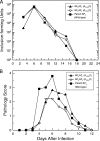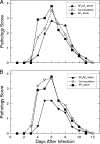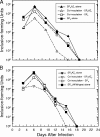Impact of azithromycin resistance mutations on the virulence and fitness of Chlamydia caviae in guinea pigs
- PMID: 20065052
- PMCID: PMC2826001
- DOI: 10.1128/AAC.01321-09
Impact of azithromycin resistance mutations on the virulence and fitness of Chlamydia caviae in guinea pigs
Abstract
Azithromycin (AZM) is a major drug used in the treatment and prophylaxis of infections caused by Chlamydia, yet no significant clinical resistance has been reported for these obligate intracellular bacteria. Nevertheless, spontaneous AZM resistance (Azm(r)) arose in vitro at frequencies ranging from 3 x 10(-8) to 8 x 10(-10) for clonal isolates of Chlamydia caviae, which is a natural pathogen of guinea pigs. Sequencing of the unique 23S rRNA gene copy in 44 independent Azm(r) isolates identified single mutations at position A(2058) or A(2059) (Escherichia coli numbering system). While SP(6)AZ(1) (A(2058)C) and SP(6)AZ(2) (A(2059)C) Azm(r) mutants showed growth defects in cell culture and were less pathogenic in the guinea pig ocular infection model than in the parent SP(6), the three isogenic C. caviae isolates grew equally well in the animal. On the other hand, coinoculation of the C. caviae parent strain with one of the Azm(r) strains was detrimental for the mutant strain. This apparent lack of association between pathology and bacterial load in vivo showed that virulence of the two Azm(r) mutants of C. caviae was attenuated. While chlamydial growth in vitro reflects the ability of the bacteria to multiply in permissive cells, survival in the host is a balance between cellular multiplication and clearance by the host immune system. The obligate intracellular nature of Chlamydia may therefore limit emergence of resistance in vivo due to the strength of the immune response induced by the wild-type antibiotic-sensitive bacteria at the time of antibiotic treatment.
Figures




References
Publication types
MeSH terms
Substances
Grants and funding
LinkOut - more resources
Full Text Sources
Medical

